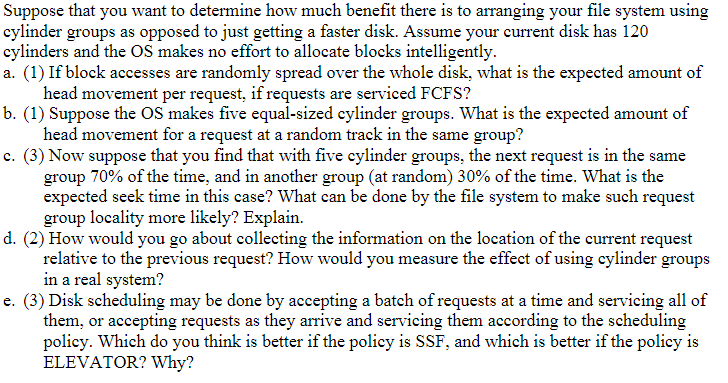[Solved]Suppose Want Determine Much Benefit Arranging File System Using Cylinder Groups Opposed Ge Q37064496

Suppose that you want to determine how much benefit there is to arranging your file system using cylinder groups as opposed to just getting a faster disk. Assume your current disk has 120 cylinders and the OS makes no effort to allocate blocks intelligently. a. (1) If block accesses are randomly spread over the whole disk, what is the expected amount of head movement per request, if requests are serviced FCFS? b. (1) Suppose the OS makes five equal-sized cylinder groups. What is the expected amount of head movement for a request at a random track in the same group? c. (3) Now suppose that you find that with five cylinder groups, the next request is in the same group 70% of the time, and in another group (at random) 30% of the time. What is the expected seek time in this case? What can be done by the file system to make such request group locality more likely? Explain. d. (2) How would you go about collecting the information on the location of the current request relative to the previous request? How would you measure the effect of using cylinder groups in a real system? e. (3) Disk scheduling may be done by accepting a batch of requests at a time and servicing all of them, or accepting requests as they arrive and servicing them according to the scheduling policy. Which do you think is better if the policy is SSF, and which is better if the policy is ELEVATOR? Why? Show transcribed image text Suppose that you want to determine how much benefit there is to arranging your file system using cylinder groups as opposed to just getting a faster disk. Assume your current disk has 120 cylinders and the OS makes no effort to allocate blocks intelligently. a. (1) If block accesses are randomly spread over the whole disk, what is the expected amount of head movement per request, if requests are serviced FCFS? b. (1) Suppose the OS makes five equal-sized cylinder groups. What is the expected amount of head movement for a request at a random track in the same group? c. (3) Now suppose that you find that with five cylinder groups, the next request is in the same group 70% of the time, and in another group (at random) 30% of the time. What is the expected seek time in this case? What can be done by the file system to make such request group locality more likely? Explain. d. (2) How would you go about collecting the information on the location of the current request relative to the previous request? How would you measure the effect of using cylinder groups in a real system? e. (3) Disk scheduling may be done by accepting a batch of requests at a time and servicing all of them, or accepting requests as they arrive and servicing them according to the scheduling policy. Which do you think is better if the policy is SSF, and which is better if the policy is ELEVATOR? Why?
Expert Answer
Answer to Suppose that you want to determine how much benefit there is to arranging your file system using cylinder groups as oppo… . . .
OR

